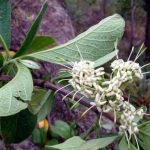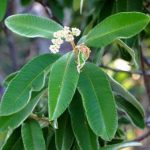TREE LIFE
October 1998
MASHONALAND CALENDAR
Tuesday 6th October. Botanic Garden Walk. Please bring the Grewia Key with you (some copies will be available) for the continuation of the revision of the Grewia genus. We will meet Tom in the car park at 4.45 for 5 p.m. – there will be a guard for the cars.
Sunday 18th October. A special this month. Our last Tree Society visit to Dichwe Lemon Forest in the Mhangura district was 9 years ago. It will be interesting to see how the forest has met the challenges of drought and human abuse. The farm owner Mr. Brown, to preserve the vegetation, has erected a fence round the whole forest, and after a couple of good rainy seasons the chances of the forest surviving are good. We will see!
Quote from TL 115 “This is an area of forest giants like Khaya anthotheca – was Khaya nyasica (the big tree of Chirinda forest). The lemons, which have become naturalised in the forest, are thought to have come in on Arab or Portuguese trade routes”. The enormous Acacia galpinii also made a lasting impression. Meet there at 10 a.m.
Saturday 24th October. At this time of year burnt patches along our roadsides yield the most amazing collections of beautiful flowers. Mark’s Walk this month will be to look at some of these along the airport road. Turning left into Harare Drive from the airport road, we will meet at 2.30 on Harare Drive near the junction.
Tuesday 3rd November. Botanic Garden Walk.
MATABELELAND CALENDAR
Sunday 4 October Mazwi – meet at Girls’ College car park at 8 a.m. for an 8.30 start.
SHAMVA 16TH AUGUST 1998
Phil and Tutty Mugford welcomed us with a superb tea so it wasn’t really surprising that our 32 members and guests showed some reluctance to get started. It was, however, an easy morning’s walk on lush green lawns with a good variety of indigenous tree species within reach.
The Shamva area is somewhat unusual in that a scattering of Zambezi valley flora appears and tends to confuse as we found during our walk about. Initially, however, more familiar species such as Combretum collinum where Dickie Graves pointed out the feature of axillary buds, is a feature we often miss. Another interesting point raised concerned Zanha africana – which is in the Sapindaceae group and this includes the domestic Litchi. Different sexes occur on separate trees, with a fleshy fruit being produced in mid-summer. Keep an eye open for them this summer.
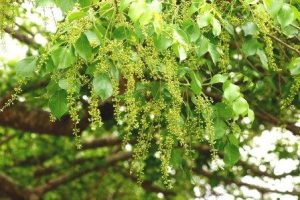
Lannea schweinfurthii. Photo: Bart Wursten. Source: Flora of Zimbabwe
For canopy woodland in this area the largest trees were Kirkia acuminata, Lannea schweinfurthii and, after some discussion, Albizia harveyi due to the very rough bark.
On finding some strange rocks Derek Henderson gave an interesting description of what these rocks are about:
Easily seen in the garden was an outcrop of a curious rock that resembled that confectionery delight ‘Monkey-nut brittle’. Made up of water-rounded pebbles set in a matrix of dark, fine-¬grained material, it is referred to as a conglomerate and is part of the so-called Shamvian group of the basement complex. Old as these rocks are, c.2.700 Million years, they represent material eroding from even older granites and greenstones that were deposited as ill-assorted sediments in a shallow water basin, and are therefore a mixture of originally sand, mud, gravel, pebbles etc. As with the other members of the Basement complex, this material was subjected to mountain building forces, and with the concurrent invasion of the later granites, considerable alteration to the structure and mineral composition occurred resulting in the compact, fairly hard rocks we see today.
Upon weathering, the soils derived from these rocks are variable but, pebbles apart, the dark matrix which was formerly mud is rich in clay-¬forming ferro magnesian minerals and these have generally produced a medium to heavy textured soil with good fertility and water-holding relationships. Due to their sedimentary origin however, these rocks do produce high silt content and most soils display problems of soil compaction and surface sealing.
The Ficus question once again, and without vociferous opposition was accepted as Ficus sur – but actually on further reference Ficus sycomorus is more likely – don’t believe everything I tell you! To keep the residents of the highveld on their toes a puzzling bit of Zambezi valley vegetation came next:
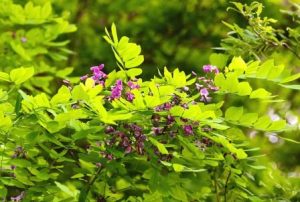
Millettia usaramensis. Photo: Bart Wursten. Source: Flora of Zimbabwe
We all agreed on the family – Fabaceae and although a guess of Lonchocarpus bussei was incorrectly made, further research at home revealed that the ‘mystree’ was in fact Millettia usaramensis. In flower this is a very pretty sight, the flowers are blue, pea-shaped and abundant.
To complete the morning stroll a superb Strychnos madagascariensis; this must be one the largest I’ve seen. Most of the now tired group spread themselves under the shade of the spreading Bauhinia petersiana sharing the space with the parked vehicles – a convenient arrangement.
To occupy the afternoon, a gentle ramble along the Mazowe River, a shallow stream at this time of year but still flowing quite strongly. The banks have numerous intrusions of a nondescript Mudstone that looks quite hard and durable until you stand on it.
The remaining tall trees along here are Xeroderris stuhlmannii with the typical margin to the flat seed giving rise to the common name of Wing Pod and Lannea schweinfurthii, which were also seen in the morning. The thickets we investigated on the opposite bank were full of tough, spine-tipped reeds and tangles of Salix subserrata with a canopy of Rhus quartiniana. An interesting Fig here was Ficus capreifolia – the sandpaper fig, which grows in alluvium and although never growing tall forms really thick colonies. Its leaf is REALLY abrasive.
Many thanks to Phil and Tutty for a superb day at Cloud 9. For the record, the number of species identified was 81.
-Andy MacNaughtan
NYONI HILLS/TOKWE GORGE: 9 AUGUST 1998
A small colony of cars set out southwards from Masvingo to Ngundu Halt and turned left towards Chiredzi. A few km along, we turned off along an insignificant gravel road towards the gorge in which the new Tokwe/Mukosi Dam is about to be built. After some hesitation, we came across a new wide gravel road which had been pushed through the Communal Land and following it hopefully we came to the gorge site.
The gorge sides are quite steep with fairly dense riverine vegetation, a lot of which had been cleared or burnt. The altitude at the flowing river is c.620 m, which is fairly low. After parking the cars, one party climbed up the slope. Festoons of the climber Cissus rotundifolia, with its thick succulent leaves were present on many trees. Bivinia jalbertii, the special tree of the Nyoni Hills, appeared to be fairly common.
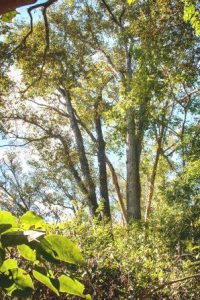
Androstachys johnsonii. Photo: Bart Wursten. Source: Flora of Zimbabwe
Here also, on the rocky hillside, was Androstachys johnsonii, the Lebombo ironwood, with its leaves green and glabrous above and white-woolly beneath. It occurs at low attitudes only in the south and east of the country. This is another member of the Euphorbiaceae with opposite leaves. (Later, on the moist side of Buchwa, we found, new to the southern division, an herbaceous species, Adenocline acuta, also Euphorbiaceae – the list of opposite-leaved Euphorbiaceae mounts up).
A riverine species we don’t see very often is the shrub, Alchornea laxiflora, here in a rich wine-red autumnal coloration. This is another Euphorbiaceae, with the more usual alternate leaves this time. Its distinguishing feature is the two hair-like “stipellae” at the base of the leaf lamina.
Another Euphorbiaceae we don’t often see is Phyllanthus pinnatus (formerly Phyllanthus kirkianus), a medium-sized shrub fairly frequent in the gorge. Also in the Euphorbiaceae, we saw two unusual species of Drypetes, both new to me, namely Drypetes reticulata and Drypetes arguta. Both have alternate simple glossy leaves, but the leaves of reticulata are more or less entire whereas arguta has toothed margins.
A remarkable shrub with trifoliate leaves and a large white Caper-like flower, which is a mass of stamens, is Thilachium africanum, from the family Capparaceae. A useful spot-character for this is the remarkable rough leaf petioles that feel crystalline to the touch and contrast with the absolutely smooth dark green leaflets.
A rather common species was *? with its paleish green leaves that, unlike Celtis, has serrations all the way round to the very base.
Two interesting species of Rubiaceae were seen. One with very tiny greenish-yellow flowers was a shrub called Canthium setiflorum. This is a plant of low altitudes. Two features of this are the grey colour of the young branches and the presence of forward-pointing appressed hairs, which give the branchlets a rough feel. The other was Lagynias dryadum, which was seen by us on the 1995 visit to the Nyoni Hills. Leaves only were seen on this occasion, whereas last time we saw the pendulous fruits as well.
A number of Strychnos spp. were seen and these proved very puzzling to name. However, it appears probable that both Strychnos henningsii and Strychnos usambarensis were present. A third species has not been clearly named yet.
In the afternoon, the various groups walked along the gorge road towards the river itself. The Fibecks and the Harrisons found some orchids, namely Ansellia africana and a species of Acampe. The children enjoyed themselves jumping or sliding down a huge pile of sand.
All in all, it was a memorable day botanically.
Once again, I would like to thank Bob Drummond for his help in naming the plants found.
MASVINGO TO BUCHWA: 10 AUGUST 1998
The next day was basically a travelling day in which our convoy of vehicles drove south from Masvingo again, crossed the Runde River and shortly afterwards turned right into the Matibi No.1 Communal Land and proceeded along a reasonably good gravel road to Buchwa.
We stopped near the Makwi River and found an interesting climber with milky latex and paired almost linear fruits, Cryptolepis obtusa. There was also a Grewia that may have been Grewia micrantha. In the sandy bed of the river there were a number of herbs of interest including Sphaeranthus peduncularis, Marsilea ephippiocarpa (a fern-ally with leaves with 4 leaflets) and a white-flowered prostrate species of Bergia.
Perhaps the most interesting stop we made was at a colony of Euphorbia malevola, which Anthon showed us on a bare rocky hill. This was a new species to me and looked in many ways similar to Euphorbia griseola, but it differed in the bluish-grey stems and perhaps in being rather shorter and less branched. At the same site was the orchid, Eulophia petersii, with its rather Sansevieria-like leaves.
BUHWA TUESDAY 11th AUGUST 1998.
We were aware that the mine had closed some months before and even though the club appeared much the same, an air of desolation hung over the pit making it an even bleaker site, a great ugly grey sore where the line of green hills once dominated the surrounding hot dry country. Even the window frames at the pit workshop had been knocked out, leaving the chilly moist wind to whistle past and our arrival must have made the day for the lone and extremely bored security guard.
Intent on finding the bamboo and with Tom Muller’s instruction to keep left brought us to a narrow path that heads past the explosives magazine and creeping along the steep hillside provided an alternative route, or so we thought. This is not for the unsteady or faint-hearted, as misplaced footwork would have resulted in a spectacular fall down a very steep rock face. The path ends abruptly here forcing a turn around but even with binoculars no bamboo on the lower slopes could be seen. On the exposed rock faces Anthon noted a fleshy grey succulent Kalanchoe sp. with bright red flowers, very showy in these damp and almost montane conditions and after further careful footwork getting back to the parked vehicles most of us opted to look at the ‘dry’ side of the mountain, particularly, as the rather tatty rope, that provided moral support if little else for those heading to the beacon, has been removed.
We stopped off at Bobbejaan Bend (there must be some history to this name) for a bite to eat, as the younger members found botany not quite the form of sustenance they like. The desire to find the bamboo kept gnawing away so after some time assembling the various members of the group, we headed back through the main mine gate and around to the other side of the range, stopping a couple of times to check, with the aid of some 10x binoculars, if distant ravines and gullies held any promise. Eventually the road petered out and the convoy of vehicles ground to halt near to a village from where a perturbed Mr. Gumbo emerged inquiring if we were harbingers of doom. Thanks to Virginia’s skill in convincing Mr. Gumbo that we REALLY WANTED TO GO HALF WAY UP A STEEP MOUNTAIN SIDE TO LOOK AT A CLUMP OF BAMBOO!, the party headed off in haste leaving (by mistake) Mark and Anthon to find their own way up the slope. Later it was revealed that the gully through which they came was full of viciously spined Mauritius thorn with an occasional overhanging branch of equally barbed Pterolobium stellatum to vary the agony. It took some time for the tattered pair to find the steeply angled path and the tail end of the main group. Around this time in the fading light, some curious climber caught our attention, only to be stirred into the relentless pull up the mountain slope with a summons from Linda up ahead in the greenery, “Mark, pick that plant and come”!
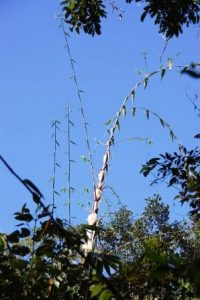
Oreobambos buchwaldii. Photo: Stephan Dondeyne. Source: Flora of Zimbabwe
After what seemed like an eternity some jubilation erupted up ahead and raising our sweating brows and smarting eyes a bamboo-like shoot appeared in a damp gully – all feelings of discomfort vanishing instantly!! Definitely a bamboo this being Oreobambos buchwaldii, however, more slender than the cultivated Asian form we are used to, this species has leaves which tend to be clustered toward the upper part of the shoot and the shade would have an effect on the leaf colour which appeared to be insipid green. Despite being the dry season this part of the mountain range catches moisture laden air from south-easterly winds, so Tom Muller’s prediction came true.
Returning to base with a sense of quiet jubilation and several carefully cut specimens for both study and possible propagation we would all like to thank Virginia for steering our guide away from the assault course and toward the bamboo and many thanks to Anthon for arranging the accommodation with the mine. Another specimen picked by Mark and Anthon in one of the prickly gullies appears to be Bivinia jalbertii! Perhaps it is more widely distributed than we realize.
-A. MacNaughtan
BIVINIA JALBERTII This topical snippet is from John Wilson.
“I have checked on the rescue exercise we carried out on this species some years ago. Commonly known as ‘Cobweb Seed’, this uncommon tree located in the Ngundu Hills was under great pressure for hut building purposes because of the straightness of its trunk and because it is borer proof. Its preferred habitat is very restricted to areas of locally high rainfall and some winter guti.
In 1979, while in charge of Chiredzi Research Station, I was asked by a Mr. Sparrow of the Department of Native Agriculture in Masvingo, if we would cultivate some trees of the species on the Station as a rescue and conservation exercise since the species was in danger of being exterminated in its natural habitat through over exploitation. We willingly agreed to help. Mr. Sparrow supplied seedlings to Triangle Ltd and us. The trees grew well where they received supplementary water but during the devastating droughts of the 80’s and especially the 1992 drought, many of the trees perished. However, there are a number of survivors, more so at Triangle than at Chiredzi Research Station, which flower and seed.
I can find no reference to the species in either Meg Coates Palgrave’s Key to the Trees of Zimbabwe, or in van Wyk and van Wyk’s Field Guide to Trees of Southern Africa. Does this suggest that the species is now considered officially extinct? Reference is made to the species in Keith Coates Palgrave’s Trees of Southern Africa as published in 1977″
John has indicated that any member of the Tree Society who would like seeds of Bivinia jalbertii can contact us through the Tree Society’s Box No and arrangements will be made to acquire some for you.
BOTANIC GARDEN WALK 1 SEPTEMBER 1998
The main subject today was the genus Grewia and altogether 9 species were examined.
Firstly, what are the features of Grewia? They are woody plants; some trees, some shrubs, some even tending to climb or at least scramble and some are very small woody suffrutices. The leaves are alternate, 3-veined from the base and, as Tom pointed out, are generally held in one plane. The leaves usually have an asymmetric base, but this may be exceptionally oblique as in Grewia monticola to hardly oblique at all as in Grewia avellana. A further feature is that Grewia hairs are generally stellate.
The flowers are yellow, white or (rarely) purple or mauve and are surrounded by 5 sepals, which are often green outside but the same colour as the petals on the inside. The fruit has 1-4 lobes. One feature which is important is whether the woody stems are rounded or whether 4-angled and it is a good idea to note this in the field.
One of the first Grewia we looked at was Grewia occidentalis, which has a very unusual mauve or purple colour. It is a forest edge species, confined to the Eastern Division – so far apparently not recorded from any of the outliers. The fruit has 2-4 deeply dissected lobes.
To deal with the white-flowered species next, we saw three: avellana, pachycalyx and stolzii.
Grewia avellana is a species of the northern lowveld. The very distinctive feature of the leaves is that they are exceptionally soft to the touch; they are also quilted and also more or less symmetrical. Both pachycalyx and stolzii have largish symmetrical leaves; however pachycalyx has fruits that are 2-4 lobed, its leaves are fairly smooth and it occurs at medium altitudes. Thus, it does not occur around Harare for example. Grewia stolzii, on the other hand, has much rougher leaves, 4-lobed fruits and it occurs in high rainfall areas (for example on rocky hills and termite mounds around Harare) and at forest edges in the eastern districts.
Turning to the yellow-flowered species, two of these have 4-angled stems: these are the very rare Grewia caffra and the very common Grewia flavescens. Grewia caffra is a rare species of the SE lowveld, this particular specimen had come from the Nyoni Hills; it differs from flavescens in the much smaller leaves. Grewia flavescens occurs in a very wide range of habitats from the savannah, Kalahari sand and even in riverine vegetation.
The var. olukondae of flavescens occurs by medium and low-altitude rivers and actually lacks the square stem of var. flavescens. Indeed the general feeling of the group was that Grewia olukondae should be accepted at species level.
A species with a very asymmetric leaf base is the extremely common Grewia monticola, which is a proper tree in habit, unlike many of the other Grewia. The leaf is also strongly discolourous; green above and white below. As with flavescens, it is very catholic in its choice of habitat occurring at all altitudes and in all soils.
The final yellow species examined was Grewia retinervis. This species is very typical of Kalahari sand; the leaves are small and noticeably rough and the fruits unlobed.
Finally, in addition to the Grewia, Tom showed us Euclea undulata. This species has small undulate leaves and at a glance looks like a funny Euclea divinorum. It occurs on small hills in Matabeleland.
Once again, our great thanks to Tom for so regularly teaching the Tree Society.
-Mark Hyde
MATABELELAND BRANCH
Within the confines of Bulawayo lie several areas that might be described as “green lungs”, allowing the City to breathe. One of these is the Mabukuwene Nature Garden. The Meikle Trust bequeathed this to our citizens, and it is administered and maintained by several Societies dedicated to the preservation and conservation of natural History.
Here, on Sunday 6th September, members of the Tree Society congregated. Tessa Ball conducted us on an informative and stimulating tour. The Garden has several laid-out paths, which meander through a very great number and variety of trees, over smooth and rocky terrain.
It was decided to study only a few species at a time, to facilitate the enduring acquisition of knowledge. As it is the end of winter and spring has not really arrived, nearly all the trees were leafless. Doubtless the sudden arrival of warmer weather will cause the Garden to green up. However, it is quite surprising how many indigenous trees are in fact evergreen.
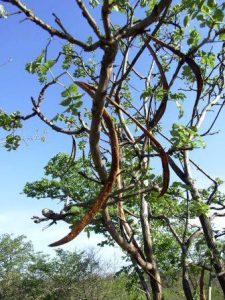
Markhamia acuminata. Photo: Rob Burrett. Source: Flora of Zimbabwe
The first one we studied would have been too, had not the frost burnt and desiccated its leaves, which hung disconsolately in brown shreds. This was Markhamia acuminata, now specifically designated Markhamia zanzibarica. The seedpods which were also still suspended were reminiscent of those found on the Zimbabwe Creeper, Podranea brycei and indeed, both belong to the Bignoniaceae family. Surprisingly, and unusually, there were no flowers visible in the Aloe nursery as we passed by.
Another study was a very large, old, Ficus glumosa. This is one of the more spectacular so-called “rock-splitters”. It displayed a goodly crown of large leaves, and sprawled over a rocky outcrop. This tree has also been renamed, previously being known as Ficus sonderi. The young shoots are densely hairy, while the mature leaves become shiny, whilst retaining hairy undersides. This particular fig is among the most splendid of its genus; providing yearlong shade, fruit that attract birds and insects, and roots that make one marvel. It also evidences a striking example of the strongest force on the planet, a growing plant.
The garden also boasts some very fine Euphorbia ingens and it is pleasing to note that whilst some of these trees are obviously declining, there are plenty of young ones to replace them.
We paused to look at Commiphora schimperi. Eric remarked how the green trunks, blotched with yellow and brown fraying bark, showed their kinship to the peeling paper bark, Combretum marlothii.
A little further on, Tessa showed us another evergreen, Mimusops zeyheri. This tree also puts forth shoots that are hairy when young, but smooth by maturity. It seems that “Mimusops” means the tree is pretending to be another, as in “mime”. All parts contain milky latex.
We found a Strychnos spinosa, heavily in fruit, some of which also lay about abundantly on the ground beneath it. I claimed a couple of these to make a pair of maracas. These fruit are used also as resonators for mbira and xylophone. Strychnine is obtained from an Indian species and curare from a South American one.
The final evergreen was Euclea natalensis. This species has far larger leaves than the others of its genus, but seems to become a smaller tree. Some trees appeared to display different leaves from those expected. Closer inspection revealed that they were infested with a parasite. One in particular had extremely large leaves. There were several discrete kinds of these mistletoes, but one can distinguish between them and the host plants by the bluish tinge of the foliage, betraying the parasite’s inability to synthesize.
Tessa, we thank you for a most enjoyable and instructive morning.
-Norma Hughes.
THE PINES OF THE NEW WORLD TROPICS
Many people tend to think of pines as essentially trees of the cooler temperate regions of the northern hemisphere, and are unaware of the wealth of Pinus species growing naturally in the tropics and subtropics. Mexico, Central America, the Caribbean islands, four small islands off the west coast of Baja California (Mexico), and the southern tip of Florida are home to 47 of the approximately 110 species of Pinus currently recognized worldwide.
In a new publication issued in November 1997 under the title PINUS (PINACEAE), authors Alios Farjon of Kew, and the late Brian T StyIes (Oxford Forestry Institute) have produced a critical revision of the pines of this region, the first since G R Shaw’s THE PINES OF MEXICO in 1909. Between these two publications the only comprehensive English-language account of the Central American pines was produced in 1950 by EEM LOOCK, a South African forester who spent two years in Mexico studying the pines and collecting seed for introduction into his own country. Loock’s THE PINES OF MEXICO AND BRITISH HONDURAS has been a sort of bible on the subject nearly 50 years, but will now have to give way to Farjon and Styles for the foreseeable future.
So, what do the pines of the New World tropics have to do with Zimbabwe? Some of them underpin the entire timber industry of this country. The best known is Pinus patula var. patula, but others of actual or potential importance in Zimbabwe are, in alphabetical order, Pinus caribaea vars. bahamensis, caribaea, and hondurensis; Pinus patula var. longepeduncuIata; Pinus pringlei; Pinus strobus var. chiapensis; and Pinus tecunumanii. Many others, again, have been under trial here for 35 years or more, but have not been satisfactory for one reason or another.
Farjon and Styles have produced the inevitable crop of changes to species names, but this has not been as severe as the recent name changes among our own indigenous flora. Where they have made major changes, however, is in shifting species about in the various taxonomic sections, which is bound to generate debate between taxonomists. The publication runs to more than 290 pages, and includes specialist contributions on wood anatomy (I D Gourlay), pollen morphology (M H Kirmann), and taxonomy based on monoterpenes (J S Birks). The anatomical drawings by Rosemary Wise have not been as well reproduced in printing as they might have been, and I regret the absence of habit photographs to show the species as they appear in their natural shapes and sizes; these would have add immeasurably to the systematic descriptions of the various species. Nevertheless, this is a publication of major importance to all who work with pines, whether botanists or foresters, and it will be well received.
-Lyn Mullin
ERYTHRINA LECTINS
Lectins are proteins that are believed to be able to cause blood (and other) cells to agglutinate (join together) by binding to specific carbohydrate residues on the cell surface. They also are reported to “stimulate” white blood cells. Lectins have commonly been derived from plant material. The most well-known lectin is phytohaemagglutinin (from the seeds of the bean, Phaseolus vulgaris).
However, numerous lectins have now been extracted from various Erythrina species (Papilionoideae) including Erythrina corallodendron, Erythrina indica, Erythrina cristagalli and Erythrina variegata.
Whilst the lectins have been most useful for biochemists to examine the structure and function of cells and cell components, they have also been investigated for treatment of aplastic anaemia, where the bone marrow fails to produce blood cells, and for stimulating the immune system, unfortunately without much success.
-Douglas Ball
ANDY MACNAUGHTAN CHAIRMAN


